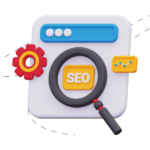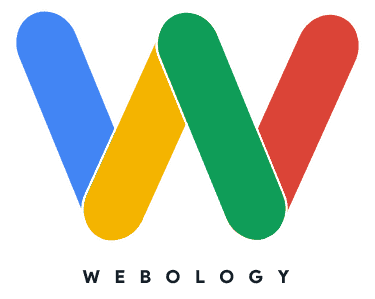Once upon a time, in a land of clicks and keywords, a website emerged from the digital forest. But lo and behold, this website was different from most…It was built with search engine optimization (SEO) in mind, an approach that optimizes the website to be more visible in search results. And with that, the website became a beacon of hope for all the kingdom 🏰 Including lead-seekers on your sales and management team!

The website quickly rose to the top of SERP results, vanquishing its foes like a knight in shining armor. Today we’re going to explain the magic that made that website so great and mighty in the eyes of Google. So follow us through this guide as we weave our way through the mystical world of SEO and learn how to build a website that ranks with the best of them right from the start! 💻🌟
How to Choose the Right Domain Name for SEO Purposes
Start your quest by picking an SEO-friendly domain name. While it is not as powerful as the early days of SEO, having an exact match or partial match domain name can still give you a serious advantage in the SERPS. So if your website’s primary keyword is “social media marketing,” you should try to find a domain name that incorporates it. You can also include geographic keywords if your business offers services in a specific local area, such as “paintingprochicago”. Here are a few more tips for finding and buying your new website domain.
1. Keep it short and sweet. Long domain names are hard to remember and difficult to type. Aim for something easy to remember and type.
2. Make sure it’s relevant. Your domain name should be related to your business or website. This will help with SEO and make it easier for people to find you.
3. Avoid hyphens and numbers. Hyphens and numbers can be confusing and make it harder for people to find your website.
How to Monitor and Track SEO Performance Before and After a Redesign
Want your new website to rule the world and vanquish your foes? You need to track its SEO performance with tools like Google Analytics and Google Search Console. If you’re a first-time website builder, set these up while you’re working on a development server. Never make changes on the live version without a backup – trust us, you don’t want to be caught off guard here…Website redesigns can be tricky! Traffic could drop if you don’t set up redirects or optimize your new pages for things like Core Web Vitals and the HCU. So, get a little baseline traffic data before you spice things up. Here are a few specifics on monitoring your traffic before, during, and after a redesign:
 Analytics: To get a better idea of how well your website is performing, setting up Google Analytics is a must. This powerful tool tracks your SEO performance and provides valuable insights, such as what keywords drive traffic, which pages are popular, and where visitors are located. It can also help you identify any issues with your website and help improve the user experience.
Analytics: To get a better idea of how well your website is performing, setting up Google Analytics is a must. This powerful tool tracks your SEO performance and provides valuable insights, such as what keywords drive traffic, which pages are popular, and where visitors are located. It can also help you identify any issues with your website and help improve the user experience.
 Google Search Console: An aspect of search engine optimization is monitoring your website’s rankings in search engine result pages (SERPs). With the help of Google Search Console (GSC), you can keep an eye on how well your website is performing. GSC lets you monitor for 404 errors and is completely free!
Google Search Console: An aspect of search engine optimization is monitoring your website’s rankings in search engine result pages (SERPs). With the help of Google Search Console (GSC), you can keep an eye on how well your website is performing. GSC lets you monitor for 404 errors and is completely free!
 Backlinks: It is important to monitor your backlinks before, during, and after a redesign since they impact the effectiveness of your search engine optimization strategy. Use tools like AHREFS to see which pages have external links and take extra care to avoid making changes to those URLs when you rebuild your website.
Backlinks: It is important to monitor your backlinks before, during, and after a redesign since they impact the effectiveness of your search engine optimization strategy. Use tools like AHREFS to see which pages have external links and take extra care to avoid making changes to those URLs when you rebuild your website.
 Analyze your content: Content is key with SEO, so analysis and optimization are needed for search engines. You can use tools like SEMrush, Surfer SEO, or Page Optimizer Pro to analyze your content and see what changes you need to make on your new site.
Analyze your content: Content is key with SEO, so analysis and optimization are needed for search engines. You can use tools like SEMrush, Surfer SEO, or Page Optimizer Pro to analyze your content and see what changes you need to make on your new site.
 Monitor your competitors: It’s important to keep an eye on your competitors to see what they’re doing and how they’re performing. You can use tools like SpyFu to monitor your competitors and what strategies are used. Include new pages in your redesign based on the most common page types they use (About, Mission, Vision, Team, etc.) Those are all important E-EAT signals.
Monitor your competitors: It’s important to keep an eye on your competitors to see what they’re doing and how they’re performing. You can use tools like SpyFu to monitor your competitors and what strategies are used. Include new pages in your redesign based on the most common page types they use (About, Mission, Vision, Team, etc.) Those are all important E-EAT signals.
The Basics of Keyword Research for SEO
Now that you’re all set up to track and measure your results, it’s time to identify the keywords that matter most for your brand’s online visibility. A design update or fresh launch of a new site is a great time to identify pages and posts that need through detailed keyword research.
But what exactly is keyword research? It’s the process of finding and analyzing words and phrases people are searching for online. By understanding what people are searching for, you can create content that is more likely to be found by search engines.
Now that you know keyword research, let’s get into the nitty-gritty. Here are some tips to help you get started:
- Start with a list of topics. Brainstorm a list of topics related to your business or website. This will help you narrow your keyword research and make it easier to find relevant keywords.
- Use keyword research tools. Free and paid tools are available to help you find the best keywords for your website. Some of the most popular tools include SEMrush and AHREFS.
- Analyze the competition. Take a look at what keywords your competitors are using. This will give you an idea of what keywords you should be targeting.
- Look for long-tail keywords. Long-tail keywords are phrases that are more specific and have less competition. They are often easier to rank for and can help you get more targeted traffic.
- Monitor your progress. Once identified the best keywords for your website, track your progress. This will help you determine which keywords are working and what needs to be tweaked.
Now that you know the basics of keyword research, it’s time to start crafting the perfect content! With a little effort, you can optimize your website copy for search engines and get more traffic. Use competitor analysis tools to identify the content length, keywords, and related phrases your competition already uses to rank in Google.
How to Write SEO-Friendly Content for Your Website
Here are some tips to help you write SEO-friendly content to make your website stand out from the crowd. And yes, it’s okay to use AI for most of the heavy lifting these days. Just be sure to edit and proofread so that your content is accurate, interesting, and informative. No one wants to read content from a 🤖 that’s as underwhelming as this Tesla update.
1. Use Keywords Strategically: Keywords are the foundation of SEO-friendly content. Make sure to include relevant keywords throughout your content, but don’t overdo it. Too many keywords can hurt your SEO rankings. This is commonly referred to as ‘overoptimization’ in SEO circles.
2. Make It Easy to Read: Break up your content into smaller chunks and use headings and subheadings to make it easier to read. This will also help search engines understand the structure of your content.
3. Add Links: Links are an important part of SEO-friendly content. Link to other pages on your website and to external sources to provide more information for your readers.
Now that we’ve covered the basics of tracking and keywords, it’s time to get a little technical and add some SEO flair to your new website with a little thing called structured data.
The Benefits of Using Structured Data for SEO
Structured data is a powerful tool for SEO, and it can help you get your website to the top of the search engine rankings. Here are some of the benefits of using structured data for SEO:
1. Increased Visibility: Structured data helps search engines understand the content of your website better, which can lead to increased visibility in the search engine results pages (SERPs).
2. Improved Crawlability: Structured data helps search engine crawlers understand the content of your website better, which can lead to improved crawlability and indexing.
3. Enhanced User Experience: Structured data can help you provide a better user experience by providing more relevant search results and making it easier for users to find what they’re looking for.
4. Increased CTR: Structured data can help you increase your click-through rate (CTR) by providing more relevant search results and making it easier for users to find what they’re searching for.
5. Improved Rankings: Structured data can help you improve your rankings by providing more relevant search results and making it easier for users to find what they’re looking for.
To get started with structured data, I highly recommend using the RankMath Pro SEO plugin. It allows you to easily copy/paste structured data from a URL, so you can go out there and steal the code from top-ranking competitors and edit it to match your brand. It’s as easy as that and the plugin is super-affordable!
How to Use Internal Linking to Improve SEO
Next up for improving your SEO on the new site is getting your internal linking game on point! Internal linking is a great way to boost your website’s visibility and help your readers find the content they’re looking for. It also assist with building topical relevance by connecting similar pieces of content on your site that’s search-engine friendly.
1. Start by linking to your content. This is a great way to show Google that your website is full of valuable content. Plus, it’s a great way to keep your readers engaged and on your website longer.
2. Get creative with your anchor text. Instead of using boring phrases like “click here” or “learn more,” try something more fun like “dive deeper” or “explore further.”
3. Don’t be afraid to link to old content. Just because something is old doesn’t mean it’s not valuable. It could be even more valuable now that it’s been around for a while.
4. Make sure your links are relevant. If you’re working on writing a page about cats, don’t link to a page about dogs unless it’s talking about something like making your pets get along (something I struggle with daily!)
5. Have fun with it! Internal linking doesn’t have to be boring. Try to make it entertaining and engaging for your readers.
Internal linking can take a lot of time, but it works beyond belief, while plugins help you automate the process. Try these to speed up your internal linking game in WordPress:
Additional Steps to Optimize Your Website for Search Engines
1. Use Optimized Meta Tags: Meta tags are HTML tags that provide search engines with information about your website. Make sure to include meta tags in your website’s code to help search engines understand your website better.
2. Optimize Your Images: Images can help make your website more visually appealing, but they can also help with SEO. Include keywords in the file names of your images and use the “alt” tag to describe the image.
3. Link Building: Link building is a part of SEO. Earn links from high-quality sites in your niche through outreach and digital PR.
4. Run a technical audit with AHREFS, SEMrush, or Screaming Frog. A technical audit is important too SEO as it can help identify any issues that may be preventing you from ranking higher in search engine results.
Blake’s Final Thoughts on Optimizing Your Website Build
Building a website: It’s fairly easy these days with the utilization of tools we have on platforms like WordPress and Shopify.
But is having SEO top-of-mind throughout the process that important? Absolutely! It’s a power move. You have to be seen to get customers. 🕵️♀️
Designing for UX is equally crucial, so the balance of form and function has to be just right. It’s a seesaw no one wants to be on the bad end of! 😓
This balancing act is best performed by an experienced team that has a wide range of skillets managing everything from HTML development to content marketing. At Webology, we’re a growing team of specialists that all work together to ensure your website is not only visually appealing but also optimized for search engines and user experience.
About The Author
 Blake Akers started his SEO journey over 10 years ago and has been perfecting his craft since then. Blake believes everyone should have the tools necessary to maximize their online reach and gain more visibility for their business or brand.
Blake Akers started his SEO journey over 10 years ago and has been perfecting his craft since then. Blake believes everyone should have the tools necessary to maximize their online reach and gain more visibility for their business or brand.
With his extensive knowledge of SEO, he has helped hundreds of clients get to the top of Google with time-tested tactics and a team of SEO professionals. He also offers consulting and workshops to help educate businesses about SEO optimization and content marketing best practices.
So if you’re looking for tips or strategies to maximize your search engine visibility, Blake has the answer! Reach out today for a complimentary audit of your existing site or a future build you’re working on. It’s best to launch with SEO best practices in place and Blake’s team can help.




